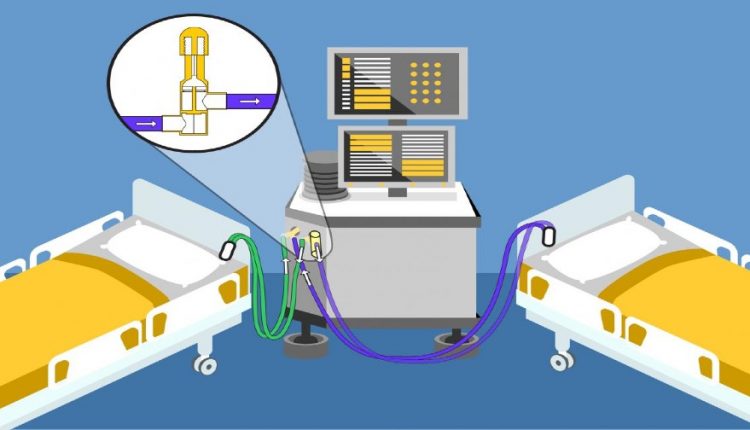
Personalized VentMITM Device Could Help Patients Share Ventilators
As the death toll from the coronavirus epidemic continues to mount, the need for more ventilators to treat critically ill patients with COVID-19 is crucial. As experts predicted a surge in coronavirus cases and a possible shortage in intensive care unit equipment, University of Michigan teams immediately got to work on a solution. The mission: to quickly develop an efficient, affordable and more controlled way to expand ventilator capacity.
Now, just weeks later, U-M and Michigan Medicine researchers have invented an individualized vent-splitter that may allow multiple patients to receive customized pressures while sharing a single ventilator. U-M has filed for patent protection on the technology, and a local start-up, MakeMedical LLC, has licensed the technology and developed it into the VentMITM device.
The VentMITM device has been tested in animals and received emergency use authorization from the U.S. Food and Drug Administration. MakeMedical, which U-M inventors have equity in, will provide the device at cost to other institutions without any profit for U-M or the company.
“It has taken relentless positive action by a large number of individuals all motivated by the common good to make this happen,” says Glenn Green, M.D., a pediatric otolaryngologist at Michigan Medicine C.S. Mott Children’s Hospital and co-developer of the technology.
The team has spent the last few weeks using in-house 3D printing to rapidly develop multiple prototypes, test them on machines in a hospital operating room and evaluate how the technology worked on pigs. The FDA’s emergency authorization now allows their device to be used on humans if needed.
“We have been working 24/7 to develop a system that could at least double ventilator capacity,” says otolaryngologist Kyle VanKoevering, M.D., of the Department of Otolaryngology-Head and Neck Surgery at Michigan Medicine and an associate faculty member in the Department of Biomedical Engineering at Michigan Engineering.
“We were looking for innovative ways to potentially help hospitals that were preparing for a ventilator shortage during the pandemic.”
The device is being manufactured in partnership with Grand Rapids, Mich. facility Autocam Medical, with hundreds of devices available for public distribution before the end of April. MakeMedical, LLC will market the product domestically and internationally, and is in the process of partnering with distributors.
MakeMedical cofounders include Green, VanKoevering, Mott pediatric head and neck surgeon David Zopf, M.D. and local business owner Owen Tien.
SARS-CoV-2, a respiratory virus, can cause complications like pneumonia and respiratory distress. In severe cases, patients will require a ventilator, a device that is attached to the windpipe and supports a patient’s lungs while their body fights the infection.
Ventilators are also used for other types of conditions, including brain and spinal cord injuries that interfere with breathing and muscle, lung and sleep disorders.
Currently, there are significant limitations to more than one patient using the same ventilator at once. One of the biggest barriers is that, without individualized controls, shared ventilator circuits will deliver only one pre-set pressure to all patients sharing the same ventilator.
“The problem is that for patients to share a ventilator using a currently available vent-splitter, they must have the same ventilator needs,” VanKoevering says. Patients sharing a ventilator need to have similarly-sized lungs with equal stiffness — or ability to stretch and expand. “Otherwise one person may receive excessive volume or pressure on their lungs, which can cause lung trauma.
“Our design would have much broader use because it solves the problem of different ventilatory requirements and monitoring for people that have different lung sizes and degrees of disease.”
The system mimics a scuba tank regulator. A scuba tank contains compressed air at a very high pressure, but the regulator delivers it slowly at the pressure the lungs need to breathe.
“Every innovative idea that comes from our group starts from powerful inspiration – in this case, Dr. Vankoevering’s ideas on how to tailor lifesaving shared ventilation,” says fellow team member and otolaryngologist David Zopf, M.D., assistant professor at Michigan Medicine and an affiliate professor in the Department of Biomedical Engineering at Michigan Engineering.
The team says because VentMITM is inexpensive, light. mobile and readily deployable, it can be delivered quickly to any place that could use it. The individualized pressure regulator system for vent splitting is expected to cost up to a hundredth of the cost of a new ventilator.
“The speed with which our team developed, tested, and verified this technology was incredible,” says Owen Tien, co-developer of the technology and founder of Ann Arbor-based 3D printing company Thingsmiths,
Tien credited Autocam’s versatility and capacity to mobilize a precision-manufactured device in less than a week as being critical to the team’s success.
Researchers represent teams from Michigan Medicine otolaryngology, anesthesia and intensive care and University of Michigan biomedical engineering. While Michigan Medicine is among hospitals that currently have adequate ventilator capacity, the researchers wanted to make the device available to any hospitals anticipating a shortage.
“We plan to make the devices available to be used across the world,” VanKoevering says. “Our goal is to help provide lifesaving care to every critically ill patient who needs it during this pandemic.”
Source: University of Michigan Medicine
